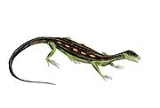
Araeoscelis
Encyclopedia
Araeoscelis is an extinct genus of reptile
, and one of the earliest diapsid
s. Fossils have been found in the United States
, dating from the early Permian
period.
Araeoscelis was around 60 centimetres (2 ft) long, and superficially resembled a modern lizard
. It differed from earlier forms, such as Petrolacosaurus
, in that its teeth were larger and blunter; possibly they were used for cracking insect
carapace
s.
Unlike its close relatives, which exhibit the two pairs of skull openings characteristic of diapsid
s, in Araeoscelis the lower pair of temporal fenestrae were closed with bone
, resulting in an euryapsid condition. This would have made the skull more solid, presumably allowing a more powerful bite.
Reptile
Reptiles are members of a class of air-breathing, ectothermic vertebrates which are characterized by laying shelled eggs , and having skin covered in scales and/or scutes. They are tetrapods, either having four limbs or being descended from four-limbed ancestors...
, and one of the earliest diapsid
Diapsid
Diapsids are a group of reptiles that developed two holes in each side of their skulls, about 300 million years ago during the late Carboniferous period. Living diapsids are extremely diverse, and include all crocodiles, lizards, snakes, and tuatara...
s. Fossils have been found in the United States
United States
The United States of America is a federal constitutional republic comprising fifty states and a federal district...
, dating from the early Permian
Permian
The PermianThe term "Permian" was introduced into geology in 1841 by Sir Sir R. I. Murchison, president of the Geological Society of London, who identified typical strata in extensive Russian explorations undertaken with Edouard de Verneuil; Murchison asserted in 1841 that he named his "Permian...
period.
Araeoscelis was around 60 centimetres (2 ft) long, and superficially resembled a modern lizard
Lizard
Lizards are a widespread group of squamate reptiles, with nearly 3800 species, ranging across all continents except Antarctica as well as most oceanic island chains...
. It differed from earlier forms, such as Petrolacosaurus
Petrolacosaurus
Petrolacosaurus was a small, long, reptile, and the earliest diapsid known. It lived during the late Carboniferous period, the Joggins strata where it was found are dated to 302 million years old....
, in that its teeth were larger and blunter; possibly they were used for cracking insect
Insect
Insects are a class of living creatures within the arthropods that have a chitinous exoskeleton, a three-part body , three pairs of jointed legs, compound eyes, and two antennae...
carapace
Carapace
A carapace is a dorsal section of the exoskeleton or shell in a number of animal groups, including arthropods such as crustaceans and arachnids, as well as vertebrates such as turtles and tortoises. In turtles and tortoises, the underside is called the plastron.-Crustaceans:In crustaceans, the...
s.
Unlike its close relatives, which exhibit the two pairs of skull openings characteristic of diapsid
Diapsid
Diapsids are a group of reptiles that developed two holes in each side of their skulls, about 300 million years ago during the late Carboniferous period. Living diapsids are extremely diverse, and include all crocodiles, lizards, snakes, and tuatara...
s, in Araeoscelis the lower pair of temporal fenestrae were closed with bone
Bone
Bones are rigid organs that constitute part of the endoskeleton of vertebrates. They support, and protect the various organs of the body, produce red and white blood cells and store minerals. Bone tissue is a type of dense connective tissue...
, resulting in an euryapsid condition. This would have made the skull more solid, presumably allowing a more powerful bite.

